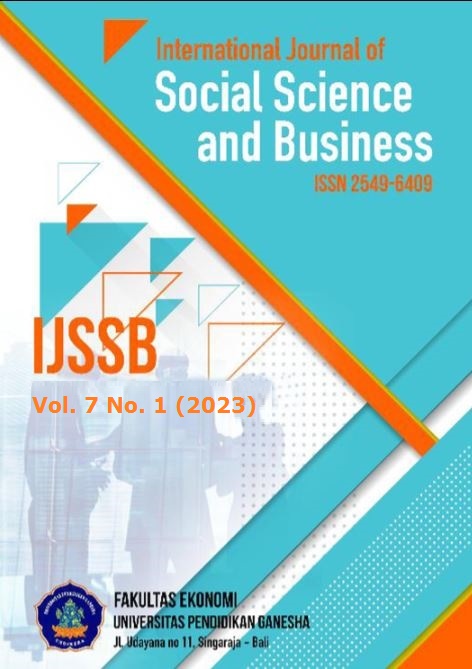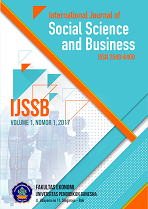Women and Coffee Shops: Negotiation of The Identity of Modernity and Piety in the Sharia Public Space
DOI:
https://doi.org/10.23887/ijssb.v7i1.44732Keywords:
Coffee shops, public spaces, sharia law, womenAbstract
Women often get discriminatory treatment in public spaces. Especially in a still strong patriarchal culture, women cannot move in public spaces. There are several studies on the image of Muslim women and their lifestyles, defending the argument about their resistance to the hegemony of religious culture to express a social identity in line with modernity. This paper intends to put forward a different argument. Based on a case study in Langsa, Aceh, this paper discusses how Muslim women negotiate a pious identity and lifestyles based on social practices at coffee shops. Data were collected through observation, interviews, and focus group discussions (FGD) with female consumers, business owners, and coffee shop staff. Using the docile agency proposed by Saba Mahmood, this paper argues that the implementation of Sharia law in Aceh causes young women to have creativity in seeking a synthesis between piety, lifestyle, and modernity. This finding challenges the views of several feminists who claim that the increasing religious performance in the public sphere impacts the marginalization of Muslim women's social identity and autonomy. In contrast to this view, the current study shows the ability of Muslim women in Aceh to find a creative combination of piety, modernity, and a lifestyle that fits their era.
References
Ahmad, A., Mahmood, Q. K., Saud, M., & Mas’udah, S. (2019). Women in Democracy: The political participation of women. Masyarakat, Kebudayaan Dan Politik, 32(2), 114. https://doi.org/10.20473/mkp.v32i22019.114-122. DOI: https://doi.org/10.20473/mkp.V32I22019.114-122
Ansor, M. (2014). Being Woman in The Land of Shari’a: Politics of The Female Body, Piety and Resistance in Langsa, Aceh. Al-Jami’ah, 52(1). https://doi.org/10.14421/ajis.2014.521.59-83. DOI: https://doi.org/10.14421/ajis.2014.521.59-83
Ansor, M., & Meutia, C. I. (2016). Jilbab dan Reproduksi Identitas Perempuan Kristen Ruang Publik Sekolah Aceh. Jurnal Kawistara, 7(2), 113–224. https://doi.org/10.22146/kawistara.15561.
Avishai, O. (2008). “Doing Religion” In a Secular World: Women in Conservative Religions and the Question of Agency. Gender & Society, 22(4), 409–433. https://doi.org/10.1177/0891243208321019. DOI: https://doi.org/10.1177/0891243208321019
Bhowon, U., & Bundhoo, H. (2016). Perceptions and Reasons for Veiling: A Qualitative Study. Psychology and Developing Societies, 28(1), 29–49. https://doi.org/10.1177/0971333615622894. DOI: https://doi.org/10.1177/0971333615622894
Bond, T. J. (2011). The Origins of Tea, Coffee, and Cocoa as Beverages. In A. Crozier, H. Ashihara, & B. F. Tom´as (Eds.), Teas, Cocoa, and Coffee: Plant Secondary Metabolites and Health (pp. 1–24). New Delhi, India: Blackwell Publishing Ltd. https://doi.org/10.1002/9781444347098.ch1. DOI: https://doi.org/10.1002/9781444347098.ch1
Bullock, K. (2018). Pious Fashion: How Muslim Women Dress. American Journal of Islamic Social Sciences, 35(3). https://doi.org/10.35632/ajiss.v35i3.486. DOI: https://doi.org/10.35632/ajiss.v35i3.486
Burke, P. J., & Stets, J. E. (2009). Identity Theory. New York: Oxford University Press. DOI: https://doi.org/10.1093/acprof:oso/9780195388275.001.0001
Fadlia, F., Lhena, R., Dan, D., & Ramadani, I. (2017). Toilet Khusus Perempuan Dan Warung Kopi di Banda Aceh (Sebuah Kajian Terhadap Konsep Keadilan Gender dan Gender Planning). Gender Equality: International Journal of Child and Gender Studies, 2(1), 11–22. https://doi.org/10.22373/EQUALITY.V2I1.1449.
Faisal, A., Putra, H. S. A., & Nugraha, W. C. R. (2018). Warung Kopi, Media dan Konstruksi Ruang Publik di Makassar. Journal Communication Spectrum, 7(2), 190–225. https://doi.org/10.36782/jcs.v7i2.1839. DOI: https://doi.org/10.36782/jcs.v7i2.1839
Glas, S., Spierings, N., & Scheepers, P. (2018). Re-Understanding Religion and Support for Gender Equality in Arab Countries. Gender and Society, 32(5), 686–712. https://doi.org/10.1177/0891243218783670. DOI: https://doi.org/10.1177/0891243218783670
Guenther, J. (2015). Gender and Globalization: Power Relations at India’s Margins. Journal of Developing Societies, 31(1). https://doi.org/10.1177/0169796X14562938. DOI: https://doi.org/10.1177/0169796X14562938
Hanani, S. (2017). Keterlibatan Perempuan dalam Kepemimpinan Publik: Studi Kepemimpinan Ketua RT Perempuan di Desa Dendun Kepulauan Riau. Kafa`ah: Journal of Gender Studies, 7(1), 79–92. https://doi.org/10.15548/JK.V7I1.158. DOI: https://doi.org/10.15548/jk.v7i1.158
Jacobsen, C. M. (2011). Troublesome Threesome: Feminism, Anthropology, and Muslim Women’s Piety. Feminist Review, 98(1), 65–82. https://doi.org/10.1057/FR.2011.10. DOI: https://doi.org/10.1057/fr.2011.10
Jeffrey, A., Staeheli, L. A., Buire, C., & Čelebičić, V. (2018). Drinking Coffee, Rehearsing Civility, Making Subjects. Political Geography, 67. https://doi.org/10.1016/j.polgeo.2017.09.013. DOI: https://doi.org/10.1016/j.polgeo.2017.09.013
Jhon, S. W. L., & Foos, K. A. (2013). Teori Komunikasi (M. Y. Hamdan, Trans.). Jakarta: Salemba Humanika.
Khotijah, K., & Madkur, A. (2018). Domestikasi Perempuan Salafi: Konstruksi Sosial Perempuan Salafi di Kota Metro Lampung. Kafa`ah: Journal of Gender Studies, 8(2), 197–212. https://doi.org/10.15548/JK.V8I2.219. DOI: https://doi.org/10.15548/jk.v8i2.219
Kriyantono, R. (2014). Teknik Praktis Riset Komunikasi (7th ed.). Jakarta: Kencana Prenada Media.
Kütük-Kuriş, M. (2020). Piety, Fashion, and Festivity in a Modest Fashion Shopping Mall in Istanbul. International Journal of Fashion Studies, 7(2). https://doi.org/10.1386/infs_00025_1. DOI: https://doi.org/10.1386/infs_00025_1
Langsakota.bps.go.id. (2021). Kota Langsa Dalam Angka. Langsa: BPS Kota Langsa.
Lukitaningsih, L., & Juliani, D. (2021). Warung Kopi Sebagai Ruang Publik dari Masa ke Masa di Kota Medan. JUPIIS: Jurnal Pendidikan Ilmu-Ilmu Sosial, 13(1). https://doi.org/10.24114/jupiis.v13i1.18639. DOI: https://doi.org/10.24114/jupiis.v13i1.18639
Mahmood, S. (2001). Feminist Theory, Embodiment, and the Docile Agent: Some Reflections on the Egyptian Islamic Revival. Cultural Anthropology, 16(2), 202–236. https://doi.org/10.1525/CAN.2001.16.2.202. DOI: https://doi.org/10.1525/can.2001.16.2.202
Mahmood, S. (2011). Politics of Piety. Princeton University Press. DOI: https://doi.org/10.1515/9781400839919
Makboul, L. (2017). Beyond Preaching Women: Saudi Dāiyāt and Their Engagement in the Public Sphere. Welt Des Islams, 57(3–4), 303–328. https://doi.org/10.1163/15700607-05734P03. DOI: https://doi.org/10.1163/15700607-05734p03
Malik, E. S. (2018). “Menjadikan Cantik” Dalam Novel Memoirs Of Geisha Karya Arthur Golden. In W. Udasmoro (Ed.), Dari Doing ke Undoing Gender: Teori dan Praktik Dalam Kajian Feminisme. Yogyakarta: Gadjah Mada University Press.
Manzo, J. (2015). “Third-Wave” Coffeehouses as Venues for Sociality: On Encounters Between Employees and Customers. Qualitative Report, 20(6). https://doi.org/10.46743/2160-3715/2015.2141. DOI: https://doi.org/10.46743/2160-3715/2015.2141
Mawardi, M., Yusmami, Y., Sufyan, M. S., & Azwir, A. (2019). Identity Negotiation of Christian and Muslim Students in Interaction Between Religions in Langsa. MIQOT: Jurnal Ilmu-Ilmu Keislaman, 43(2), 261–277. https://doi.org/10.30821/MIQOT.V43I2.643. DOI: https://doi.org/10.30821/miqot.v43i2.643
McGinty, A. M. (2014). Emotional Geographies of Veiling: The Meanings of The Hijab For Five Palestinian American Muslim Women. Gender, Place & Culture, 21(6). https://doi.org/10.1080/0966369X.2013.810601. DOI: https://doi.org/10.1080/0966369X.2013.810601
Miles, M. B., A, M. H., & Saldana, J. (2014). Qualitative Data Analysis; A Methode Sourcebook (Third Edit). United States of America: Arizona State University.
Moss, A. J., Blodorn, A., Camp, A. R. Van, & O’Brien, L. T. (2017). Gender Equality, Value Violations, and Prejudice Toward Muslims. Group Processes & Intergroup Relations, 22(2), 288–301. https://doi.org/10.1177/1368430217716751. DOI: https://doi.org/10.1177/1368430217716751
Mukodi, M., & Burhanuddin, A. (2015). Domestifikasi Perempuan Samin Dalam Khasanah Masyarakat Islam Modern. Al-Tahrir: Jurnal Pemikiran Islam, 15(2), 411. https://doi.org/10.21154/al-tahrir.v15i2.271. DOI: https://doi.org/10.21154/al-tahrir.v15i2.271
Mursyidin, M. (2018). Pergeseran Pola Interaksi Warung Kopi Pada Masyarakat Aceh Barat. Community : Pengawas Dinamika Sosial, 4(2), 201–210. https://doi.org/10.35308/JCPDS.V4I2.992. DOI: https://doi.org/10.35308/jcpds.v4i2.992
Pamungkas, A. S. (2015). The Dakwah Media in Post Suharto Indonesia: From Politics of Identity to Popular Culture (The Case of Ummi). Universitat Zu Berlin.
Perales, F., & Bouma, G. (2018). Religion, Religiosity, and Patriarchal Gender Beliefs: Understanding the Australian Experience: Journal of Sociology, 55(2), 323–341. https://doi.org/10.1177/1440783318791755. DOI: https://doi.org/10.1177/1440783318791755
Pirmasari, D. A. (2020). To Veil or Not to Veil? Islamic Dress and Control Over Women’s Public Appearance. Journal of Gender Studies, 30(2), 136–149. https://doi.org/10.1080/09589236.2020.1863199. DOI: https://doi.org/10.1080/09589236.2020.1863199
Putri, R. D. (2020). Representasi Identitas Muslimah Modern “Jilbab Traveler” dalam Novel Karya Asma Nadia. JSW (Jurnal Sosiologi Walisongo), 4(2), 117–132. https://doi.org/10.21580/JSW.2020.4.2.5878. DOI: https://doi.org/10.21580/jsw.2020.4.2.5878
Rinaldo, R. (2014). Pious and Critical: Muslim Women Activists and the Question of Agency. Gender and Society, 28(6), 824–846. https://doi.org/10.1177/0891243214549352. DOI: https://doi.org/10.1177/0891243214549352
Roviana, S. (2016). Identitas Perempuan Aceh Pasca Pemberlakuan Syari‘ah Islam: Sebuah Kajian Kepustakaan. Ilmu Ushuluddin, 3(1), 81–100. https://doi.org/10.15408/JIU.V3I1.4853.
Saadawi, N. El. (1982). Women and Islam. Women’s Studies International Forum, 5(2), 193–206. https://doi.org/10.1016/0277-5395(82)90027-9. DOI: https://doi.org/10.1016/0277-5395(82)90027-9
Setiati, G. (2015). Gender dan Place Attachment Pada Coffe Shop di Bandung (Studi Kasus Roemah Kopi). Jurnal Sosioteknologi, 14(3), 298–310. https://doi.org/10.5614/SOSTEK.ITBJ.2015.14.3.8. DOI: https://doi.org/10.5614/sostek.itbj.2015.14.3.8
Srimulyani, E. (2013). Gender in Contemporary Acehnese Dayah: Moving Beyond Docile Agency? In B. J. Smith & M. Woodward (Eds.), Gender and Power In Indonesian Islam: Leaders, Feminists, Sufis and Pesantren Selves (pp. 66–80). Routledge. https://doi.org/10.4324/9780203797518-11.
Tong, J. K. C., & Turner, B. S. (2008). Women, Piety, and Practice: A study of Women and Religious Practice in Malaysia. Contemporary Islam, 2(1). https://doi.org/10.1007/s11562-007-0038-3. DOI: https://doi.org/10.1007/s11562-007-0038-3
Van Geel, A. (2016). Separate or together? Women-only public spaces and participation of Saudi women in the public domain in Saudi Arabia. Contemporary Islam, 10(3). https://doi.org/10.1007/s11562-015-0350-2. DOI: https://doi.org/10.1007/s11562-015-0350-2
Wright, J., Zeltmann, S., & Griffin, K. (2017). Coffee Shops and Cash Crops: Gritty Origins of the World’s Favorite Beverage. Competition Forum, 15(1), 102–112. Retrieved from http://abc.cardiff.ac.uk/login?url=https://search.proquest.com/docview/1960313465?accountid=9883.
Yeetin, P., & Buakaew, J. (2018). Kopi coffee shops: Political interaction spaces for Trang locals. Kasetsart Journal of Social Sciences, 39(2), 284–290. https://doi.org/10.1016/J.KJSS.2018.05.001. DOI: https://doi.org/10.1016/j.kjss.2018.05.001
Downloads
Published
How to Cite
Issue
Section
License
Copyright (c) 2022 Mawardi Siregar

This work is licensed under a Creative Commons Attribution-ShareAlike 4.0 International License.











